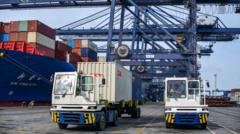The Raja Ampat archipelago, renowned for its diverse marine life, is facing severe environmental degradation due to nickel mining activities, which the Indonesian government recently attempted to curb. Despite the revocation of several mining permits, local and global activists remain wary of potential legal challenges.
Nickel Mining in Raja Ampat: A Clash Between Green Energy and Marine Conservation

Nickel Mining in Raja Ampat: A Clash Between Green Energy and Marine Conservation
As nickel extraction intensifies in Indonesia's Raja Ampat, ecological devastation threatens one of Earth's richest marine regions, prompting government action and environmental concerns.
In the heart of Indonesia’s Raja Ampat archipelago—a region often referred to as the "Amazon of the Seas"—intensive nickel mining is raising alarms about environmental degradation. Stunning aerial footage provided by Global Witness highlights the striking consequences of this mining surge, which has decimated forests and contaminated surrounding waters, endangering one of the planet’s most biologically diverse marine ecosystems.
This week, the Indonesian government made a significant decision by revoking permits for four out of five mining firms in the area, a move welcomed by various environmental organizations. The Ministry for the Environment emphasized the importance of protecting Raja Ampat's exquisite biodiversity, asserting that action is crucial against destructive mining practices.
Images captured during an investigation reveal alarming landscapes: expansive deforestation and sediment runoff infiltrating the vibrant coral reefs. Over the past four years, mining activities have expanded by 500 hectares—an area roughly equivalent to 700 football fields—placing significant pressure on this fragile habitat.
Despite the government’s recent steps, concerns linger among conservationists over potential legal threats from mining companies seeking to overturn the decision. One mining operation, known for rich nickel deposits on Gag island, has been permitted to continue extracting resources. Environmental advocates like Dr. Mark Erdmann, an esteemed coral reef expert, praised the government’s actions, underscoring community outrage as a catalyst for change.
As demand for nickel—crucial for electric vehicle batteries—continues to intensify, similar environmental challenges are emerging globally. Notably, Indonesia reportedly generates over half of the world’s nickel production, leading the way in a rapidly evolving market. However, this surge is not without consequences. Studies indicate links between mining practices and increased flooding and landslides, aggravating local socio-environmental conditions.
Dr. Michaela Guo Ying Lo from the University of Kent highlighted the paradox presented by mining operations in Sulawesi, where economic benefits from nickel mining come at the cost of deteriorating environmental well-being. The impacts on water and air quality have raised pivotal questions regarding the true cost of this seemingly green energy solution.
Furthermore, environmental advocate Imam Shofwan warned that while nickel is touted as a remedy for the climate crisis, it inherently contributes to deforestation and jeopardizes local farmer and fisher livelihoods. Coastal regions, which host nickel deposits, are especially vulnerable to climate change threats, such as rising sea levels.
Dr. Erdmann reflects on this conflict, noting: “The nickel dilemma is a horrible one... But what is the acceptable damage that we’re willing to see?” The balance between catalyzing economic growth and maintaining ecological integrity remains a daunting challenge for Indonesia. While calls for action have resonated in the halls of government, the road to sustainable extraction practices remains fraught with uncertainty—challenging the narrative of clean energy versus environmental preservation in one of the most vibrant marine ecosystems on Earth.
This week, the Indonesian government made a significant decision by revoking permits for four out of five mining firms in the area, a move welcomed by various environmental organizations. The Ministry for the Environment emphasized the importance of protecting Raja Ampat's exquisite biodiversity, asserting that action is crucial against destructive mining practices.
Images captured during an investigation reveal alarming landscapes: expansive deforestation and sediment runoff infiltrating the vibrant coral reefs. Over the past four years, mining activities have expanded by 500 hectares—an area roughly equivalent to 700 football fields—placing significant pressure on this fragile habitat.
Despite the government’s recent steps, concerns linger among conservationists over potential legal threats from mining companies seeking to overturn the decision. One mining operation, known for rich nickel deposits on Gag island, has been permitted to continue extracting resources. Environmental advocates like Dr. Mark Erdmann, an esteemed coral reef expert, praised the government’s actions, underscoring community outrage as a catalyst for change.
As demand for nickel—crucial for electric vehicle batteries—continues to intensify, similar environmental challenges are emerging globally. Notably, Indonesia reportedly generates over half of the world’s nickel production, leading the way in a rapidly evolving market. However, this surge is not without consequences. Studies indicate links between mining practices and increased flooding and landslides, aggravating local socio-environmental conditions.
Dr. Michaela Guo Ying Lo from the University of Kent highlighted the paradox presented by mining operations in Sulawesi, where economic benefits from nickel mining come at the cost of deteriorating environmental well-being. The impacts on water and air quality have raised pivotal questions regarding the true cost of this seemingly green energy solution.
Furthermore, environmental advocate Imam Shofwan warned that while nickel is touted as a remedy for the climate crisis, it inherently contributes to deforestation and jeopardizes local farmer and fisher livelihoods. Coastal regions, which host nickel deposits, are especially vulnerable to climate change threats, such as rising sea levels.
Dr. Erdmann reflects on this conflict, noting: “The nickel dilemma is a horrible one... But what is the acceptable damage that we’re willing to see?” The balance between catalyzing economic growth and maintaining ecological integrity remains a daunting challenge for Indonesia. While calls for action have resonated in the halls of government, the road to sustainable extraction practices remains fraught with uncertainty—challenging the narrative of clean energy versus environmental preservation in one of the most vibrant marine ecosystems on Earth.




















